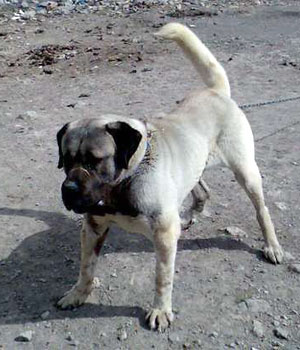Turkish Bulldog
 The rare Turkish Bulldog is a cross between the American Pit Bull Terriers and many Turkish and Asian fighting and baiting dogs. Developed for the sole purpose of fighting other dogs and baiting bears, bulls and big cats, the Turkish Bulldog is extremely aggressive and reportedly untrainable, handled only by experienced "sportsmen". Most dogs under this name are Kangal and Pit Bull crosses, but other breeds are also used, most notably the Turkmen Alabai and English Bullterrier, as well as the Turkish Mastiff crossed with American Bulldogs, Bullmastiffs and various bandogges. Unknown outside its native borders and disregarded as a mutt in Turkey, the Izmir Bulldog is only moderately popular in the dog-fighting community. Even though it is known as the Izmir Pit Dog in some circles, there is likely very little connection to the city itself, apart from such dogs occasionally encountered there, but in no greater numbers than in other parts of Turkey, where it is commonly referred to as simply "Pit-Kan", as per the usual recipe for its creation.
The rare Turkish Bulldog is a cross between the American Pit Bull Terriers and many Turkish and Asian fighting and baiting dogs. Developed for the sole purpose of fighting other dogs and baiting bears, bulls and big cats, the Turkish Bulldog is extremely aggressive and reportedly untrainable, handled only by experienced "sportsmen". Most dogs under this name are Kangal and Pit Bull crosses, but other breeds are also used, most notably the Turkmen Alabai and English Bullterrier, as well as the Turkish Mastiff crossed with American Bulldogs, Bullmastiffs and various bandogges. Unknown outside its native borders and disregarded as a mutt in Turkey, the Izmir Bulldog is only moderately popular in the dog-fighting community. Even though it is known as the Izmir Pit Dog in some circles, there is likely very little connection to the city itself, apart from such dogs occasionally encountered there, but in no greater numbers than in other parts of Turkey, where it is commonly referred to as simply "Pit-Kan", as per the usual recipe for its creation.
 There is little attention paid to any appearance standards, but two main types of the Turkish Bulldog are found today; the smaller dogs used for pit fighting and the larger variant supposedly employed for baiting duties, although such Pit-Kans are also usually battling other dogs more than doing anything else. The body is generally muscular, with broad shoulders and a wide chest. The head is large, with the length of the muzzle depending on the dog's ancestry, with American Bulldog and Bullmastiff-based crosses usually having shorter muzzles and rounder heads. Most dogs tend to have a shorter back than a Kangal, but the appearance of multi-generational crosses can be deceiving at times. The dense coat varies in length, coming in all colours. Ears and tails are usually removed at birth, but many dog are left unaltered.
There is little attention paid to any appearance standards, but two main types of the Turkish Bulldog are found today; the smaller dogs used for pit fighting and the larger variant supposedly employed for baiting duties, although such Pit-Kans are also usually battling other dogs more than doing anything else. The body is generally muscular, with broad shoulders and a wide chest. The head is large, with the length of the muzzle depending on the dog's ancestry, with American Bulldog and Bullmastiff-based crosses usually having shorter muzzles and rounder heads. Most dogs tend to have a shorter back than a Kangal, but the appearance of multi-generational crosses can be deceiving at times. The dense coat varies in length, coming in all colours. Ears and tails are usually removed at birth, but many dog are left unaltered.
The coat is short and flat, common in a variety of colourings, with the most common ones being cream, fawn, black and brindle, with or without a black mask or white markings on the chest and feet. The average height is 22 inches for the smaller type, while the largest specimens can reach up to 27 inches at the withers.
